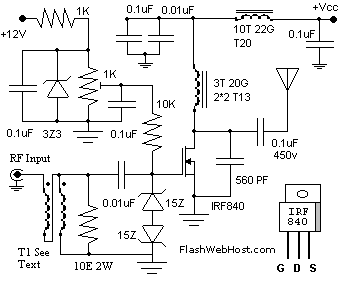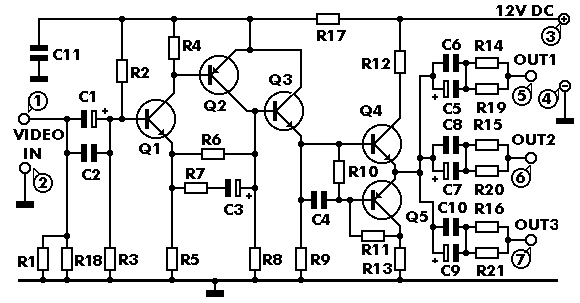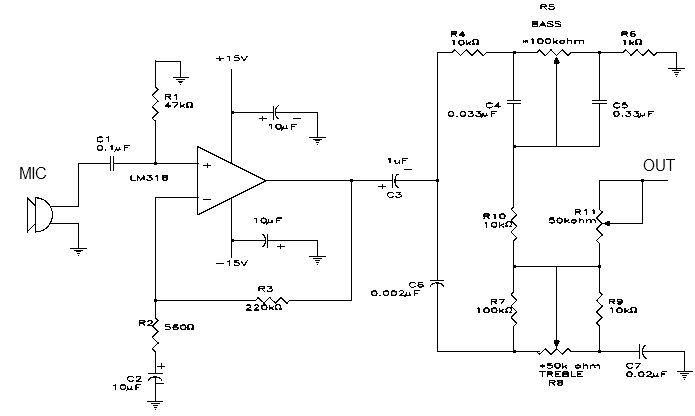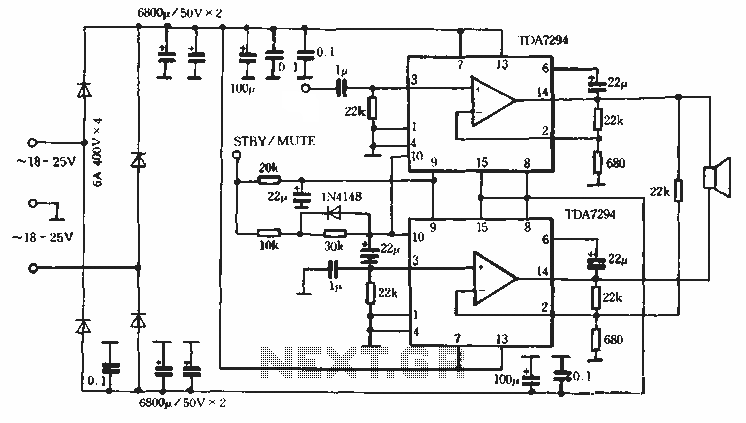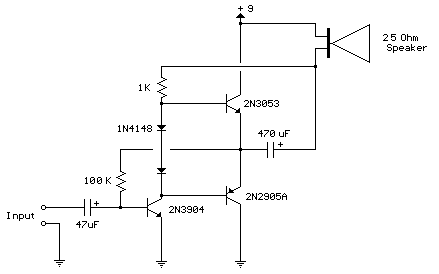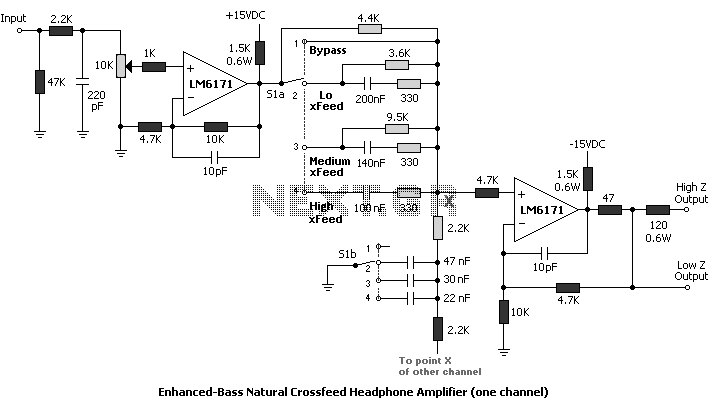
25 Watt amplifier
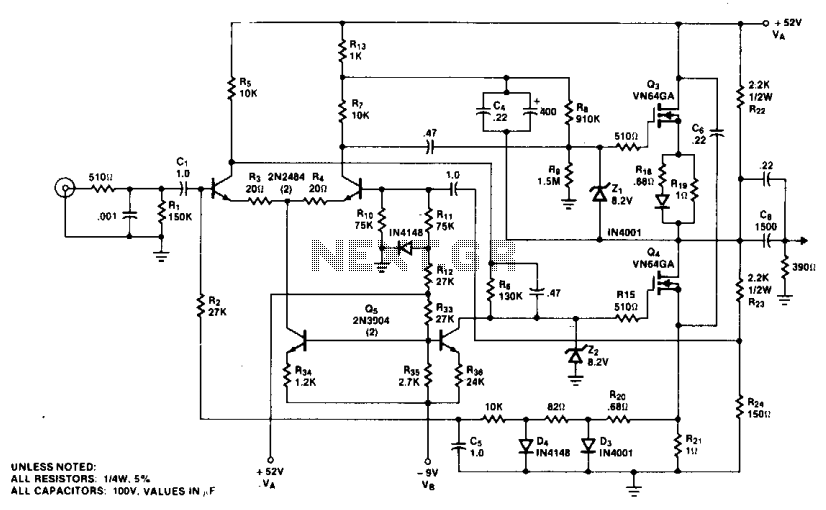
Transistors are utilized as current sources, with the base drive for these transistors sourced from the main power supply VA. This configuration ensures that their collector current is proportional to the rail voltage, maintaining the voltage on the cliff-amp collectors close to VA/2. The sensitivity of quiescent current (Iq) to VA is approximately 3.4 mA/volt when VB is kept constant, while the sensitivity of Iq to VB is -15 mA/volt when VA remains constant. In a practical amplifier with a non-regulated supply, variations in power output lead to fluctuations in VA without affecting VB. Consequently, a slight increase in Iq with power output serves to compensate for the 3.4 mA/volt sensitivity of Iq to VA. Furthermore, in scenarios involving line voltage variations, as VA is roughly five times VB, the sensitivities tend to cancel each other out, resulting in a net sensitivity of around 2 mA/volt.
Transistors serve as essential components in current source applications, particularly in amplifier circuits where maintaining stable performance under varying supply conditions is critical. The configuration described allows for effective control of the collector current, which is directly influenced by the main power supply voltage (VA). The relationship between VA and the quiescent current (Iq) is a key aspect of the amplifier's design, ensuring that the output remains stable despite fluctuations in the supply voltage.
In this setup, the quiescent current's sensitivity to the main power supply voltage (3.4 mA/volt) indicates that for every volt change in VA, the Iq will adjust accordingly, assuming the base voltage (VB) is held constant. Conversely, the negative sensitivity of Iq to VB (-15 mA/volt) implies that increases in VB will lead to a decrease in Iq when VA is constant. This dual sensitivity highlights the importance of maintaining stable voltage levels in both VA and VB to ensure optimal amplifier performance.
In practical applications, particularly in non-regulated power supply systems, fluctuations in power output can cause variations in VA. However, since VB remains unaffected, the slight increase in Iq with higher power output can help to mitigate the sensitivity of Iq to VA. This self-compensating mechanism is beneficial in maintaining consistent amplifier behavior under varying load conditions.
Additionally, when considering line voltage variations, the ratio of VA to VB (approximately 5:1) plays a significant role in determining overall sensitivity. The cancellation of sensitivities due to this ratio results in a net sensitivity of about 2 mA/volt, which indicates a more balanced response to changes in line voltage. This characteristic is crucial for ensuring that the amplifier can handle real-world voltage fluctuations without significant performance degradation, thereby enhancing the reliability and efficiency of the circuit.Transistors are used for current sources. Base drive for these transistors is derived from the main power supply VA, so that their collector current is proportional to the rail voltage. This feature holds the voltage on the cliff-amp collectors close to VA/2. The sensitivity of Iq to VA is about 3.4 mA/volt when VB is held constant; the sensitivity of Iq to VB is -15 mA/volt when VA is held constant.
In a practical amplifier with a non-regulated supply, variations in power output will cause fluctuations in VA, but will not affect VB; therefore, having Iq increase slightly with power output will tend to compensate for the 3.4 mA/volt IqVa sensitivity. In the case of line voltage variations, since VA is about five times VB, the sensitivities tend to cancel, leaving a net sensitivity of about 2 mA/volt. 🔗 External reference
Transistors serve as essential components in current source applications, particularly in amplifier circuits where maintaining stable performance under varying supply conditions is critical. The configuration described allows for effective control of the collector current, which is directly influenced by the main power supply voltage (VA). The relationship between VA and the quiescent current (Iq) is a key aspect of the amplifier's design, ensuring that the output remains stable despite fluctuations in the supply voltage.
In this setup, the quiescent current's sensitivity to the main power supply voltage (3.4 mA/volt) indicates that for every volt change in VA, the Iq will adjust accordingly, assuming the base voltage (VB) is held constant. Conversely, the negative sensitivity of Iq to VB (-15 mA/volt) implies that increases in VB will lead to a decrease in Iq when VA is constant. This dual sensitivity highlights the importance of maintaining stable voltage levels in both VA and VB to ensure optimal amplifier performance.
In practical applications, particularly in non-regulated power supply systems, fluctuations in power output can cause variations in VA. However, since VB remains unaffected, the slight increase in Iq with higher power output can help to mitigate the sensitivity of Iq to VA. This self-compensating mechanism is beneficial in maintaining consistent amplifier behavior under varying load conditions.
Additionally, when considering line voltage variations, the ratio of VA to VB (approximately 5:1) plays a significant role in determining overall sensitivity. The cancellation of sensitivities due to this ratio results in a net sensitivity of about 2 mA/volt, which indicates a more balanced response to changes in line voltage. This characteristic is crucial for ensuring that the amplifier can handle real-world voltage fluctuations without significant performance degradation, thereby enhancing the reliability and efficiency of the circuit.Transistors are used for current sources. Base drive for these transistors is derived from the main power supply VA, so that their collector current is proportional to the rail voltage. This feature holds the voltage on the cliff-amp collectors close to VA/2. The sensitivity of Iq to VA is about 3.4 mA/volt when VB is held constant; the sensitivity of Iq to VB is -15 mA/volt when VA is held constant.
In a practical amplifier with a non-regulated supply, variations in power output will cause fluctuations in VA, but will not affect VB; therefore, having Iq increase slightly with power output will tend to compensate for the 3.4 mA/volt IqVa sensitivity. In the case of line voltage variations, since VA is about five times VB, the sensitivities tend to cancel, leaving a net sensitivity of about 2 mA/volt. 🔗 External reference
